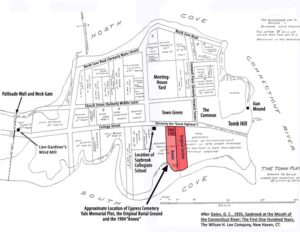Original Settlers
Few of the “Men of Quality” for whom the colony was originally established actually ended up coming to Saybrook from England. In fact, patentee George Fenwick was the only one ever to make it. As a result, in 1644 after only nine years, Fenwick sold the patent (deed) to the Colony of Connecticut for 1600 pounds sterling, reserving for himself the right to “enjoy” any of the housing associated with the Fort for ten years as well as revenue derived from duties paid by vessels entering the river for the same ten year period. It was said that, along with being discouraged that the new settlement hadn’t gone as planned, he was distraught over the death of his wife Lady Fenwick in 1645.
 Following the failure of the original colony and the sale of the patent, the land within the “Town Plat” on Saybrook Point was ultimately divided up in 1650 and a home lot was given to each of the new inhabitants, whom have been described more as the “middle class ” than the “Men of Quality”. It’s thought that few of the original 1650 inhabitant’s names appear on markers in Cypress Cemetery because (1) the graves of the earliest burials were not marked, and (2) many “removed” to Norwich in 1660 with Reverend James Fitch to start a new community there. It is thought that Matthew Griswold, the gentleman that was “secretary” to George Fenwick and to whom the land on Griswold Point in Old Lyme was given, is buried along with some other early inhabitants underneath what is now the paved portion of College Street fronting the cemetery.
Following the failure of the original colony and the sale of the patent, the land within the “Town Plat” on Saybrook Point was ultimately divided up in 1650 and a home lot was given to each of the new inhabitants, whom have been described more as the “middle class ” than the “Men of Quality”. It’s thought that few of the original 1650 inhabitant’s names appear on markers in Cypress Cemetery because (1) the graves of the earliest burials were not marked, and (2) many “removed” to Norwich in 1660 with Reverend James Fitch to start a new community there. It is thought that Matthew Griswold, the gentleman that was “secretary” to George Fenwick and to whom the land on Griswold Point in Old Lyme was given, is buried along with some other early inhabitants underneath what is now the paved portion of College Street fronting the cemetery.
Review of old maps suggests that during the 1600’s, College Street was a mere pathway that may have been located slightly north of its present location. In that the black wrought iron fence and the defined northern boundary wasn’t established until the middle 1800’s and the traveled pathway may have been located further north, it is possible that interments occurred in that area. Descendants of the Griswold family still residing in Old Lyme have said that they are unaware of Matthew’s place of rest, so this legend would seem plausible.
Other unmarked graves, legend says, include those of Attawanhood (Joshua Uncas) and his son Abimelech, Mohegan indians that befriended the original inhabitants. Their graves are said to be marked with small, triangular stones and are located in the southeast area of the cemetery near South Cove.